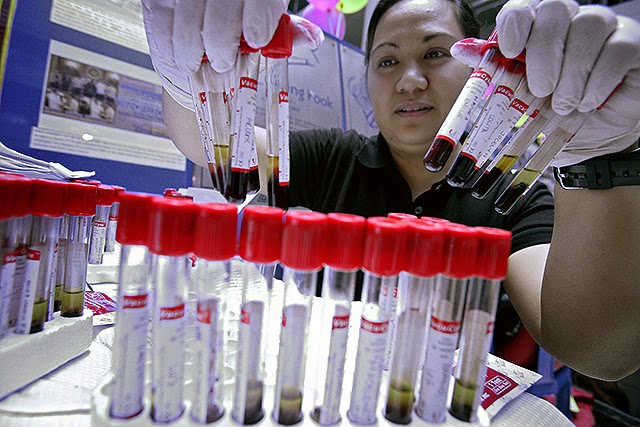The World Health Organization, in tandem with the Hepatological Society of the Philippines, launched an awareness campaign to spread information about hepatitis B on Oct. 2.
Present at the launch of the B-Aware Campaign were a panel of four experts and professionals: Dr. Nick Walsh of the WHO's Western Pacific Region Office; Maricel de Quiroz-Castro, technical officer of WHO Philippines; Hepatological Society president Dr. Eternity Labio and Chris Muñoz of the Yellow Warriors Society of the Philippines.
Muñoz said that the information drive hopes not only to prevent the rise of hepatitis B cases in the Philippines but also to alleviate the discrimination a person with the disease may experience at the workplace, or even before entering one.
“Discrimination at the workplace is due to a lack of knowledge on the part of the employer,” Muñoz explained. “Better understanding of hepatitis B is not only cost-effective, but it will help save a life.”
He also said that their gauge for campaign effectivity is its ability to trend on social media.
Labio said, “We are launching a multimedia campaign. We have a Facebook page, but we also want the campaign broadcast in print, radio, TV, and social media. We are pooling efforts—the more partners we have, the better.”
Castro noted that the Department of Health’s hepatitis B program, for example, saw the need to partner with the maternal health program “because mother’s education is very important for baby’s health.”
According to WHO, hepatitis B is "a potentially life-threatening liver infection caused by the hepatitis B virus. It is a major global health problem. It can cause chronic liver disease and chronic infection and puts people at high risk of death from cirrhosis of the liver and liver cancer."
Problems and possible solutions
Walsh explained that the number of Hepatits B patients in the Western Pacific region—home to 25 percent of the world's population—is disproportionate to that of the rest of the world, with the Philippines particularly affected.
Majority of chronic carriers contract the disease at birth, with 90 percent of all newborns being at risk for Hepatitis B. However, cheap and affordable vaccines are available and administered to all newborns for free, as mandated by Republic Act 10152, or the Immunization Act of 1992.
“We have the tools to prevent these deaths. There have been significant gains over the years, but the number of immunizations still leave a lot to be done,” said Walsh.
Castro cited the findings of the 2012 Hepatitis Birth Dose Assessment as the reasons for why the Philippines is still behind with regard to immunizing individuals against the disease:
- Home deliveries affect the timely delivery of the birth dose, which must be within the first seven days of life.
- There were funding difficulties before the government put the Republic Act in place.
- The participation of the private sector is a bit wanting; the government requests that companies and private physicians submit reports with regard to immunization, but this is not done with regularity.
“The WHO is trying to engage member countries into making a comprehensive Heptatitis B regional strategy, and the Philippines will be a key country,” explained Castro.
Walsh added, “We think all countries can learn from each other. In the next six months, we will have more data and we will see how countries will move forward in addressing this problem.”
It was also noted that a multisectoral coalition is being looked into, as part of the local solution to the disease’s prevalence. With regard to treatment beyond childhood immunizations, pharmaceutical companies and pediatricians are interested in partnering with WHO Philippines and the HSP for this campaign.
Another of the campaign’s goals is for hepatitis B treatment to be included in PhilHealth coverage.
Be aware, be tested
Casting light on Castro’s statement are the facts Labio and Castro presented: 16.7 percent of all Pinoy adults have been infected with Hepatitis B—that's 1 out of 6 adults, or 8 million Filipinos. Twenty to 30 percent of these people will develop chronic liver complications, with 9,000 people dying yearly of them.
Vaccination is also the treatment for adults, although those are quite expensive. Labio noted that many adults do not even know they are infected until they are diagnosed with liver cirrhosis.
Immunization at birth and throughout infancy (6 weeks, 10 weeks, and 14 weeks) is still the best weapon against hepatitis B. The WHO's goal, then, is to lessen hepatitis B prevalence in children to 1 percent by 2017.
“The hepatitis vaccine has been given to over a billion infants around the world,” said Walsh. “It’s one of the most effective vaccines we have; it is uncommon to not be vaccinated in other countries. It comes down to education and preference and we need mechanisms—this campaign is one of those.”
Castro noted that a lot of progress has been observed since the introduction of the hepatitis B vaccine in the Philippines. However, with regard to government handling of the situation, Labio said, “We need to see more in terms of implementation.”
“Sharing information is a very powerful tool for influencing government, helping Filipinos find gainful employment, and most importantly, saving a life,” she added.
Castro closed the conference by reiterating the campaign’s slogan, “We invite everyone to be aware, be tested, and be an advocate against hepatitis B.” — BM, GMA News
source: gmanetwork.com

